#and also fulfill a specific role in a community
Text
.
#i don't know what I'm supposed to do about being too self-aware for therapy#like im sorry that i can't convince myself into a level of delusion in order to function in this society#cuz that's basically what CBT is#just talking yourself into certain mindsets until they stick#but like#i can't get past the fact that that is literally self-inflicted brain trauma?#like ok the output might be positive#aka being able to do the dishes without having a panic attack#but i cannot get to that point because im aware that im just attempting to trick myself into a state of delusion#i know it works for so many people#but i cannot just convince myself that i'm mentally healthy#i do not get dopamine or seratonin from completing tasks or taking care of myself like “normal” brains do#and forcing myself to reframe my thought process isn't going to change that#I can only distract myself so much ya know?#i'm just frustrated that the answer to my brain being the way it is is to just force it to be a different way#but that's literally TRAUMA like is anyone gonna wake the fuck up to that????#did you know that our brains are almost exactly the same brains as the early homosapiens??? aka literal cavemen?#I'm working with A CAVEMAN brain that just wants to do specific little tasks and be creative#and also fulfill a specific role in a community#now in this current society we have to fulfill ALLLL the roles#the cleaning the cooking the planning the scheduling etc etc etc#i simply do not have the brain for all of that#plus im TIRED#because i have adhd and probably have autism so im using every last drop of my energy to just survive#so I don't have energy for all the “extra” stuff#which unfortunately for me includes things like laundry and vacuuming and hobbies and seeing friends and being active and touching grass#and this expensive ass therapist is just going to try to convince me that i in fact *do* have the energy and i just need to feel my feeling#and stop telling myself i cant#im not telling myself anything#like does *anyone* fucking get it???
5 notes
·
View notes
Text
.
#some of yall seem to think 2s is just a 1-to-1 find-and-replace for Native and lgbt#2s is an umbrella term for a broad range of (mostly) culturally-dependant identities#native people are not a monolith and gender conceptions were (and are) not the same from tribe to tribe or from nation to nation#2s ppl often fulfill specific cultural and religious roles in their families/communities#someone being Native and trans does not necessarily mean that they are also 2s
2 notes
·
View notes
Text
🤱🏻 Moon & Mother
the moon in your birth chart can offer insights into the mother’s personality and your relationship with her ~ 🌙

SUN-MOON: your mother is confident and direct, likely pushing you to toughen up and build confidence, shaping your identity and the way you carry yourself. however, this encouragement may come across as controlling, as she may have a specific image or standard she wants you to meet. this could create tension as you navigate between fulfilling her expectations and developing your own individuality. at times, she might seem arrogant and boastful, adding complexity to the dynamic
MERCURY-MOON: your mother is talkative, expressive, and enjoys logical discussions, but she can be critical, nitpicking, and lacks tact in communication. she values rationality over sensitivity and may often disregard or overlook your feelings. you might find yourself having frequent verbal arguments with her, but also chitchats. overall, her influence on you is significant, shaping how you think and communicate and likely instilling a preference for logic and directness.
VENUS-MOON: your mother is charming, sociable, and probably popular. her ability to effortlessly get her way into people has influenced you, leading you to believe that charm can make life smoother. despite your mother’s appealing qualities, there may be a two-faced and shallow side to her. your relationship with her is probably good, with few arguments, unless other aspects say otherwise. she played a significant role in shaping how you approach making connections and socializing.
MARS-MOON: your mother’s assertiveness and impatience, coupled with struggles in expressing emotions, likely resulted in frequent outbursts. her combative and defensive nature might have contributed to a home environment marked by conflicts and arguments. in response to this, you may have developed a heightened sense of alertness and the tendency to react quickly to diffuse or navigate such situations. your mother’s influence shaped the way you deal with emotions, leaning towards an aggressive approach
JUPITER-MOON: your mother is joyful, open-minded, and generous. however, her indulgent nature suggests a tendency to be overly lenient. your mother’s strong and dramatic reactions suggest that she responds intensely to various situations. perhaps she easily takes things personally and often makes small things a big deal. she may have influenced your wisdom, religious, and philosophical views, as well as your general outlook on life.
SATURN-MOON: your mother could have been emotionally guarded and strict, but she was also diligent and hardworking. early on in life, you were given a strong sense of responsibility, as your mother may have been preoccupied with her other duties. the bond between you two is serious and reserved, marked by limited displays of affection. growing up in an emotionally distant family taught you how to manage your emotions without support, which led you to develop emotional resilience.
URANUS-MOON: it seems that your mother exhibits moodiness and emotional distance, indicating a potential absence or distance in your relationship. childhood experiences marked by changes and unpredictability may have contributed to the inconsistency in your connection with her. despite this, she instilled in you a sense of independence and the ability to handle your own things. however, growing up, you may have likely felt like the odd one out in the family.
NEPTUNE-MOON: this can suggest that your mother may have been absent, either physically or emotionally, perhaps due to substance use or illness. another possibility is that she experienced abuse, and you had to bear the weight of her suffering, making you very sensitive to her emotions. despite your mother’s selflessness and compassion, there’s a deceptive side to her, meaning you might not have fully understood the true depth of her nature as you grew older.
PLUTO-MOON: your mother possesses a complex mix of traits, as she is both deeply loving and controlling. this can make you feel suffocated because she switches between being affectionate and dominating, showing strong and unpredictable emotions. it creates a storm in your relationship with her, sometimes leaving you confused as to why she acts that way. the power struggles you have with her add to the overwhelming feeling of conflicting forces in your relationship.
this is based on my observation & interpretation. take what resonates 💜 @mstase
#astro#astro community#astro notes#astrology#astrology observations#astro observations#astro placements#astrology community#astrology notes#moon aspects#astrology aspects#astrology moon#astrology blog
1K notes
·
View notes
Text
You know what I feel we need more of?
Community centers.
Specifically, places where people can gather, have fun, host events or even just hang out. Similar to what libraries are, but not quite--a place where kids can be loud and rowdy and hang out, make friends, practice sports. Though they definitely should still have quiet areas, maybe craft rooms too. A nice place to go to and hang out after school before you're ready to head home--or a safe place to stay if you don't want to head home. Community centers could also still be fantastic for adults too--they could be used as a place to host classes on different crafts, or repairs, etc.--and still be a perfectly valid place to hang out and seek refuge.
Places like these do exist in many places in a few different forms, but a lot of them are directly tied to organizations and groups that may make people more hesitant to partake in them (ie churches, Police Athletic Leagues), or they have a cost barrier to taking part of the amenities (YMCA). While these places are definitely suitable and fulfilling for many people, they're often limiting and stifling for others--if not just flat-out inaccessible. Not to mention, they don't all fill the roles I mentioned above.
I think having robust community centers would be great for societies all over. I'll admit, my imagination is a bit grand--community gardens, sports rec rooms, swimming pools, reading and craft rooms, a repair cafe, a food cafe, maybe a dorming area for overnight stays, soup kitchens, showers, mutual aid closets and such.
Though I guess that brings about the question of how this would be funded. With churches, it's tithes and other forms of community fundraising. With police athletic leagues, its... taxes, I guess? Alongside other donations. And with the YMCA, it's memberships that provide the funding for their amenities. My initial instinct is to say a mix of taxes and maybe some community contributions would be what funds a good community center, but then there comes the issue of some places having better or worse community centers depending on the median income of their area... especially when you see how places like libraries already get little funding in favor of larger policing budgets (the libraries in my city are all closed on Sundays, and have shorter hours in general, for example)
I know I'm just rambling at this point. I just think community centers are cool! They're punk! And we should have them--cool, fun community centers!
#out of queue#ani rambles#solarpunk#community#i know I'm kinda preaching to the choir here but man. community centers. want more of them.#oh its 1am no wonder I'm rambling
1K notes
·
View notes
Note
Why does screenwriting have such a weird format? I know it's standard for scripts of all kinds, but it's also alien? It almost looks like it's designed for someone to write quickly??
Why are screenplays the way they are?
Screenplays are interesting pieces of writing because while they can read very beautifully, and quality is apparent in some scripts more than others, it is a medium that is extremely purposeful. The script is not the final destination of the idea, and that is what you have to remember. The script is, more than anything, a map. It gives the cast, crew, and producers the necessary information to get a sense of the story so that it can be adapted effectively. Therefore, the quality of a script is judged by a completely different rubrick:
Adaptability: Scripts are naturally going to go through many changes to serve the filmmaking process. Filmmaking is a fundamentally collaborative process so other members of the group must be able to effectively interpret the script well enough to make strategic improvements. Scripts are definitely works of art in their own right, but the design must account for adaptation into a completely different medium and you will not always be the person making executive decisions on how that is to be done.
Clarity: Creative liberty is acceptable in a lot of forms of writing, and style is definitely apparent in a screenwriter's work, but that is primarily to be found in how they practically form the elements of the story, rather than how it is delivered in words. The clearer your meaning and intent in a script, the easier it will be for the other people you're collaborating with to interpret and translate into the next medium. Even if your work is meant to be experimental, abstract, or avant garde, the script is the place where you make sure everyone that is inside of the production understands the point, so that they can help you make sure everyone outside of it is confused in the desired way. Your talent and style can be showcased in the way you demonstrate the particular brand of humor or suspense or drama in the descriptions, dialogue, and dialogue cues.
Efficiency: Format is extremely strict in the industry because it is a collaborative medium that often brings together hundreds of crew members who are all from different backgrounds/experience. The one thing that must remain consistent and reliable is the legibility of the script. The gaffer and the producer alike must be able to pick up the script and find what they need to learn in order to fulfill their role. The format of the script denotes specific crew member's cues in specific places so they know how to find what's expected of them quickly and efficiently. While on larger productions, there's often many directorial positions who are coordinating and communicating with the crew members who handle more detail oriented jobs, that isn't always the case.
My advice, if you're looking to gain experience in writing scripts that are actually meant to be adapted is to practice self-discipline, pragmatism, and distance. Your script won't always belong to you. There isn't the autonomy in screenwriting that you have in prose. Learn the rules of screenwriting, then learn how to enhance them in your own way.
Best of luck,
x Kate
–
Masterlist
If you enjoy my blog and wish for it to continue being updated frequently and for me to continue putting my energy toward answering your questions, please consider Buying Me A Coffee, or pledging your support on Patreon.
176 notes
·
View notes
Text
this informational piece is directed to the gale fandom specifically:
grooming is a tactic where someone methodically builds a trusting relationship with a child or young adult, their family, and community to manipulate, coerce, or force the child or young adult to engage in sexual activities.
1. Choosing a victim - The predator often chooses a child who is obviously vulnerable. Children who are withdrawn, low on confidence, emotionally deprived and with less parental supervision are particularly at risk.
2. Building access & trust - Sexual abuse often begins with friendship. The abuser can also take on other roles such as a romantic partner, a mentor, a caregiver or an authority figure. The abuser spends time in getting to know the victim's likes, dislikes and habits and pretending to share common interests. The perpetrator establishes trust with the child by making them feel special, sometimes through gifts or excessive compliments and attention. This is especially dangerous for vulnerable children who do not experience attention in their daily lives. In the trust development stage, offenders aim to develop a trusting friendship or relationship with their victim. This can involve several tactics, including:
a) praising the child for their maturity and intelligence;
b) encouraging the child to disclose personal information;
c) syncing their language with that of the child;
d) highlighting mutuality (i.e., similar interests, attitudes and behaviors between the offender and child); and finally,
e) portraying themselves as being trustworthy and nice.
3. Filling a need with gifts & favors - Giving the victim small gifts and favours is a strategy used by perpetrators to make the child feel indebted. Trust is further built by sharing intimate life details, going on special outings and giving the child access to things they normally wouldn’t get. Once the offender has identified a child’s needs, they will try to be the “hero” to the child who gives them what they desire. Examples include gifts, extra attention, or affection. This causes the child to see them as highly important and even idolized. They won’t want to upset them in risk of not getting the void in their life fulfilled.
4. Isolating - The groomer actively tries to isolate the child from people who may be watchful or helpful. This kind of isolation creates deeper connection & dependency. The offender also exhibits exemplary behaviour before parents of the victim & manipulates them into trusting the relationship. They will use this trust to create situations in which they are alone with the child. Time spent alone also reinforces the “special connection” the child feels they have with the offender. This “special connection” is further reinforced when the offender convinces the child that they love and appreciate them more than anyone else.
5. Initiating sexual contact - With the power over the child victim established through emotional connection coercion or one of the other tactics, the perpetrator may eventually initiate physical contact with the victim. It may begin with touching that is not overtly sexual (though a predator may find it sexually gratifying) and that may appear to be casual (arm around the shoulder, pat on the knee, etc.). Gradually, the perpetrator may introduce more sexualized touching. By breaking down inhibitions and desensitizing the child, the perpetrator can begin overtly touching the child. At this stage, the offender will exploit a child’s natural curiosity through physical touch and excitement. They will begin to teach the child sexual preferences and manipulate what the child responds to. The child begins to see themselves as a sexual being prematurely and the relationship with the offender now takes on a sexual term.
6. Post-abuse maintenance - The goal of the final stage is to ensure the child remains trapped in the cycle of abuse and loyal to the abuser, by either reinforcing and maintaining trust in order to prevent disclosure, or by explicitly threatening or blackmailing the child or their loved ones. This can also be reinforced and maintained by, for instance, giving the child affection, praise or encouragement for one’s actions.
#grooming cw#abuse cw#sa cw#we have reached a point where i feel like it really needs to be explained#once again#some people still seem to think that gale’s lack of realization means that he wasn’t actually groomed#while he simply hasn’t reached that stage yet during the game#healing is a process#he barely scratched the surface of everything mystra had done to him#namely 1) that mystra was wrong to request him to kill himself#and 2) that he was used as amusement and eventually discarded#perspectives he only gained through tav & the tadpole gang’s input#when elminster arrives he still fully believes that his sacrifice is the only logical choice#it speaks#gale dekarios
192 notes
·
View notes
Text
Attempting to get to where we were, I got an incredibly unlikely success on the Rhetoric check. I think this scene is also really good so consider this a little bonus.
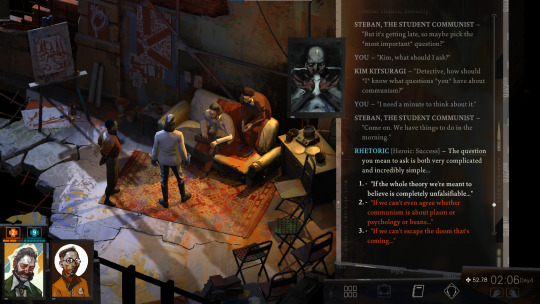
RHETORIC [Heroic: Success] - The question you mean to ask is both very complicated and incredibly simple...
"If the whole theory we're meant to believe is completely unfalsifiable..."
"If we can't even agree whether communism is about plasm or psychology or beans..."
"If we can't escape the doom that's coming..."
STEBAN, THE STUDENT COMMUNIST - The young man waits patiently for you to finish.
"... and the rest of world conspires to invade and massacre us when we dare to stand up for our beliefs..."
"... and whenever we *do* try it just devolves into a corrupt farce..."
"... and we waste all our time arguing over who's secretly a liberal or not..."
STEBAN, THE STUDENT COMMUNIST - "Yes?"
VOLITION [Easy: Success] - Say it.
"..what's the point?"
STEBAN, THE STUDENT COMMUNIST - The young man considers your words for a minute.
COMPOSURE [Medium: Success] - You're witnessing his ironic armour melt before you. This is his *true self* you're seeing now.
EMPATHY [Formidable: Failure] - There's something going on in there, but his innermost sanctum is still beyond your reach...
STEBAN, THE STUDENT COMMUNIST - "The theorists Puncher and Wattmann -- not infra-materialists, but theorists nonetheless -- say that communism is a secular version of Perikarnassian theology, that it replaces faith in the divine with faith in humanity's future..."
"I have to say, I've never *entirely* understood what they mean, but I think maybe the answer is in there, somewhere."
"Wait, you're saying communism is some kind of religion?"
"But what if you don't believe there *is* a future?"
"But what if humanity keeps letting us down?"
STEBAN, THE STUDENT COMMUNIST - "Only in this very specific sense. Communism doesn't dangle any promises of eternal bliss or reward. The only promise it offers is that the future can be better than the past, if we're willing to work and fight and die for it."
2. "But what if humanity keeps letting us down?"
STEBAN, THE STUDENT COMMUNIST - "Nobody said fulfilling the proletariat's historic role would be easy." A tight smile. "It demands great faith with no promise of tangible reward. But that doesn't mean we can simply give up."
"Even when they ignore us?"
"Even when they laugh at us?"
"Even when they shoot at us?"
STEBAN, THE STUDENT COMMUNIST - "Especially then."
ECHO MAKER - "And of course, we'll be shooting right back."
VOLITION [Easy: Success] - So young. So *unbearably* young...
HALF LIGHT [Medium: Success] - Why do you see the two of them with their backs against a bullet-pocked wall, all of a sudden?
INLAND EMPIRE [Easy: Success] - Their faces, blurred yet frozen as though in ambrotype. You were never *that young*, were you?
STEBAN, THE STUDENT COMMUNIST - "I guess you could say we believe it *because it's impossible*." He looks at the scattered matchboxes on the ground. "It's our way of saying we refuse to accept that the world has to remain... like this..."
"Broken."
"Unfinished."
Say nothing.
STEBAN, THE STUDENT COMMUNIST - "Yes, that's a good way to think of it, broken, but not irreparable."
"It's a nice thought."
"I don't know if I believe it, though."
STEBAN, THE STUDENT COMMUNIST - "You've got to believe in *something*. Otherwise, what are you doing?"
EMPATHY [Easy: Success] - His words aren't really directed at you. He's wrestling with himself now...
ECHO MAKER - "Steban, it's getting pretty late."
Ok, that's the end of that diatribe. Rejoin me for the canonical version of events shortly.
103 notes
·
View notes
Text

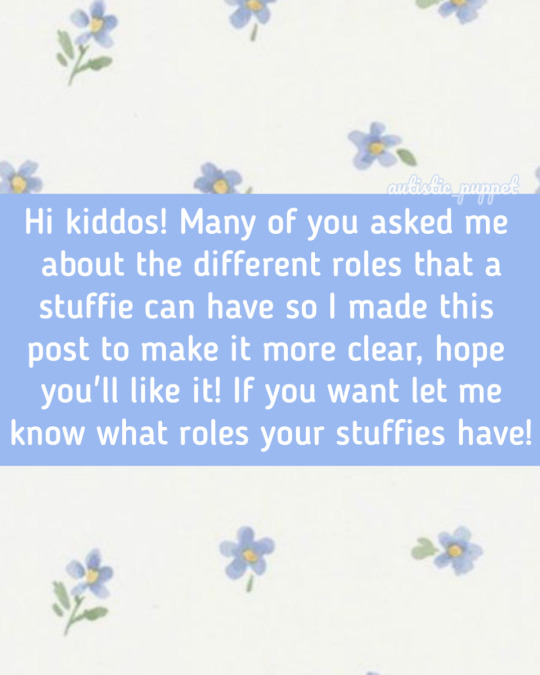
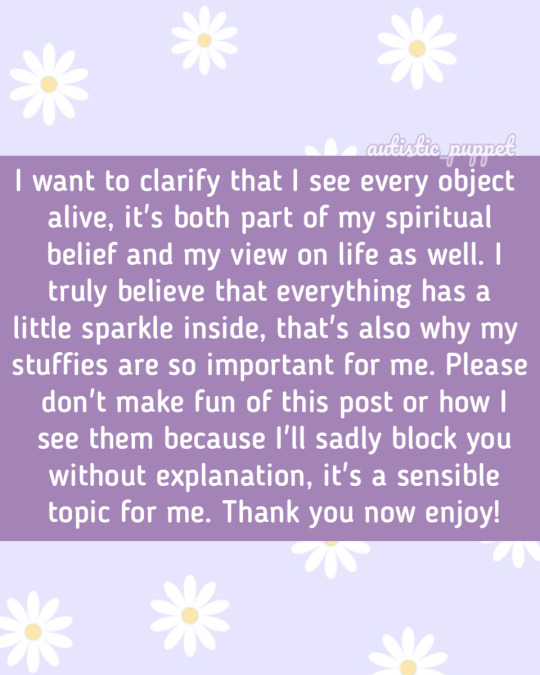




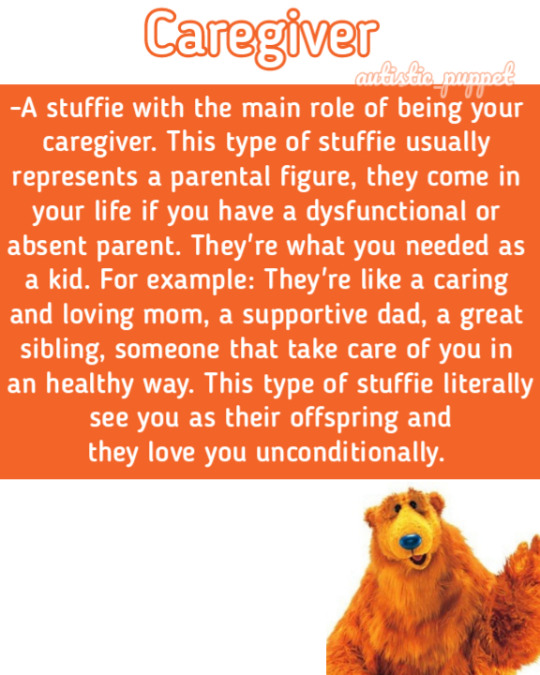
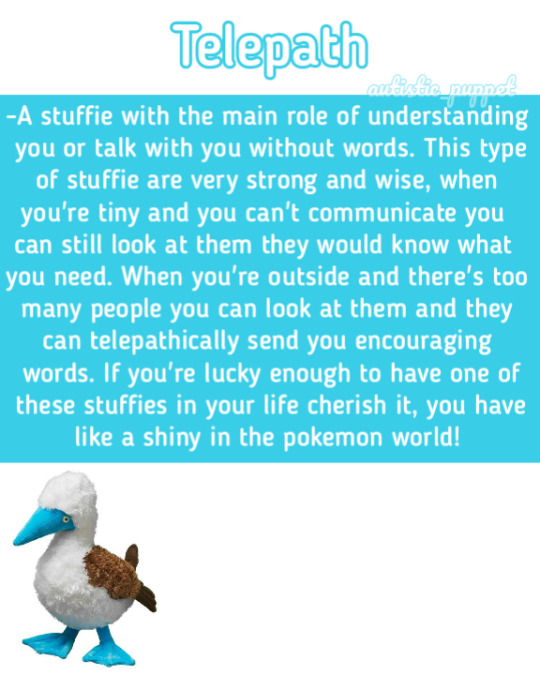
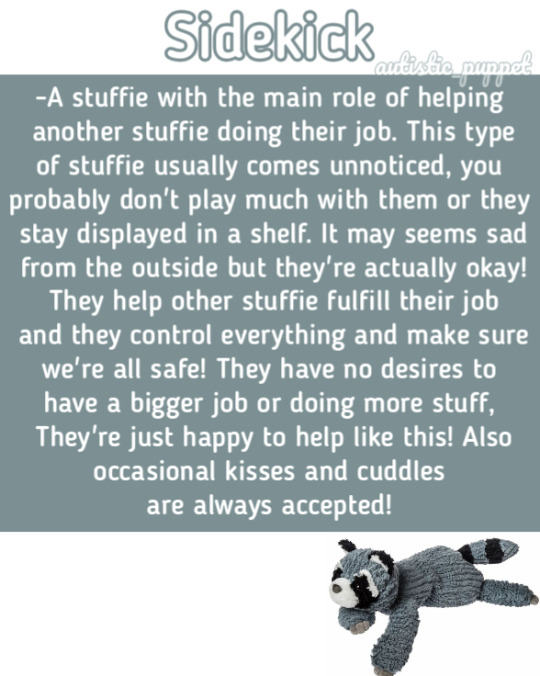
Roles of stuffies
Hi kiddos! Many of you asked me about the different roles that a stuffie can have so I made this post to make it more clear, hope you'll like it! If you want let me know what roles your stuffies have!
I want to clarify that I see every object alive, it's both part of my spiritual belief and my view on life as well. I truly believe that everything has a little sparkle inside, that's also why my stuffies are so important for me. Please don't make fun of this post or how I see them because I'll sadly block you without explanation, it's a sensible topic for me. Thank you now enjoy!
Comforter
- A stuffie with the main role of comforting you. They're usually old stuffies or related to a specific period of your life, they give you a sense of a calmness when you're tiny or upset. They usually help you ground yourself when you're crying or they can give you strength when you hug them, the truth is that they love being with you.
Protector
- A stuffie with the main role of protecting you both emotionally and physically. This stuffie usually stay the most by your side, they protect you from nightmares, monsters under bed, bad people, social anxiety when you're outside,etc...They're very tough and love their job.
Memory holder
-A stuffie with the main role of holding a specific memory or sensation for you. This type of stuffie usually can hold a single memory but it's strong enough that when you look at them you can't forget it. For example: A trip at the zoo, a friend, a date with a caregiver, a good day, a parent,etc..They're very sensitive and when you look at them they loves to see you smile.
Silly amplifier
- A stuffie with the main role of making you laugh or being carefree again. They're usually related to something you love and that makes you instantly tiny, when you look at this stuffie you can't stop giggling and jumping. They're infused with a magic spell that is full of love and joy and all the good things, it's a rare and beautiful magic and They're honored to use it with you.
Caregiver
-A stuffie with the main role of being your caregiver. This type of stuffie usually represents a parental figure, they come in your life if you have a dysfunctional or absent parent. They're what you needed as a kid. For example: They're like a caring and loving mom, a supportive dad, a great sibling, someone that take care of you in an healthy way. This type of stuffie literally see you as their offspring and they love you unconditionally.
Telepath
-A stuffie with the main role of understanding you or talk with you without words. This type of stuffie are very strong and wise, when you're tiny and you can't communicate you can still look at them they would know what you need. When you're outside and there's too many people you can look at them and they can telepathically send you encouraging words. If you're lucky enough to have one of these stuffies in your life, you have like a shiny in the pokemon world!
Sidekick
-A stuffie with the main role of helping another stuffie doing their job. This type of stuffie usually comes unnoticed, you probably don't play much with them or they stay displayed in a shell but you never touch them. It may seems sad from the outside but they're actually okay! They help other stuffie fulfill their job when they control everything and make sure we're all safe! They have no desires to have a bigger job or doing more stuff, They're just happy to help like this! Also occasional kisses and cuddles are always accepted!
Remember that you CAN like and reblog my posts but you CAN'T repost even with credits or use the tag #mine under this post!
#agere#sfw agere#age regression#ageregression#agere community#cglre#cglre community#mine#age regression community#agedre#agedre community
696 notes
·
View notes
Text
TENTH LORD IN MARS NAKSHATRAS
Thanks for your patience in waiting for the next part of the series - I’m glad you guys are interested. As always, recorded for my own benefit, published for yours. General disclaimer is in my bio. Credit to KRSchannel for inspiring this post.
Find your 10th lord here, and find your 10th lord’s nakshatra here.
The 10th house rules our life’s honor. It represents the services we perform for society as well as the reputation we earn as a result. It is associated with the father and the career because traditionally, this is where both our standing in society and the role we performed in society would come from - inherited through the father’s family line. However, in our contemporary world, this isn’t always the case, which is why it’s important to know the grander themes at play.
The three Mars-ruled nakshatras are Mrigashira, Chitra, and Dhanistha.
Mars is a planetary object that represents motivation, force of will, and personal drive. It is the pursuit of pleasure and the incurring of wrath. While Venus rules earthly and rational matters, such as the aesthetic of beauty and the value of wealth, Mars rules our desires which are primal and sublime. He is impulse, passion, giving us strength and making us vulnerable simultaneously. He is also fear and terror. More than any traditional planet, Mars is tied to the cycle and the transformation of life and death, as the ruler of the 1st and 8th house. His impact is severe, earnest, and compelling, and is escaped by no one.
DO YOU HAVE YOUR 10TH LORD IN A MARS-RULED NAKSHATRA? THAT MEANS YOU…



Mick Jagger, Ryan Reynolds, and Bob Marley all have their tenth lords in Mars ruled nakshatras. Mick's is in Mrigashira, Ryan's is in Chitra, and Marley's is in Dhanistha.
… HAVE A PUBLIC PERSONA MOST SHAPED AND DEFINED BY YOUR IMPULSES, INDIVIDUALITY, AND INDEPENDENCE.
Those born with this placement usually find themselves at odds with the rest of society. Though they don't necessarily fail to fit in with the culture of their time, they tend to let their gut instincts dictate the way they engage with it and this results in distinct and memorable individuals who stand out from the crowd, and cause waves with just their personalities and the effect they have on others. Thus, they may be capable of contributing to massive culture shifts. However, they're also liable to let their impulses lead them to scandal and enmity.
Mars is a chthonic planet, and so it's no surprise we see it ruling the lord of the house of status and legacy in many of the most famous and widely mourned celebrities but that doesn't make this a death sentence for the influential. More than anything, fame in tangent with this placement signifies someone who inspires controversy, not with their choices or behaviors, but in their possessing fame at all. Other people will argue over the legitimacy of whatever talent, beauty, act, or positive attribute to which their fame is attributed. Their fame may be cyclical, as may be the public's support or enmity towards them.
MORE ON THE SPECIFICS OF MRIGASHIRA, CHITRA, AND DHANISTHA BELOW!
IF MRIGASHIRA RULES THE TENTH LORD, YOU…



Bette Davis, Lord Byron, and Milo Ventimiglia all have their tenth lords in Mrigashira. Others with this placement are Louis Lumiere, Prince Philip, Claudia Schiffer, Babe Ruth, Christopher Lee, and George Lucas.
Find yourself constantly searching within your professional and public spaces for something more fulfilling than what you have.
Throw yourself into your work, and are eager to learn whatever you can to develop and improve your craft, or your social standing.
Communicate articulately about responsibilities and projects, as well as political beliefs and social causes that are important to you.
Network and establish your personality easily, as your work and your society inspire you to engage in debate consistently.
Have an eye for major trends and business opportunities, and can capitalize on them just as they take off, leading the charge.
AND YOU MAY FIND…
Pursuit, stalking, or cheating might be a pattern at your workplace.
Quickness is the key trait that defines your reputation: in casting judgement, responding to a crisis, and haste to get desired results.
Your work has you spending time in recreation-friendly spaces: parks, street markets, town squares, playgrounds, your home, etc.
Sensitivity to your surroundings makes you adept at resolving immediate problems involving authorities or a formal setting.
Over-sensitivity, whether to sensory experiences, to tone, or to social graces, can lead to overreactions that confuse people.
MRIGASHIRA is the Searching Star. Industries and career types favored are those involving art, expression, navigation, earth, textiles, animals, trends, sales, advertising, agriculture, telecommunications, occult studies, crafts, research, drama, and travel.
IF CHITRA RULES THE TENTH LORD, YOU…

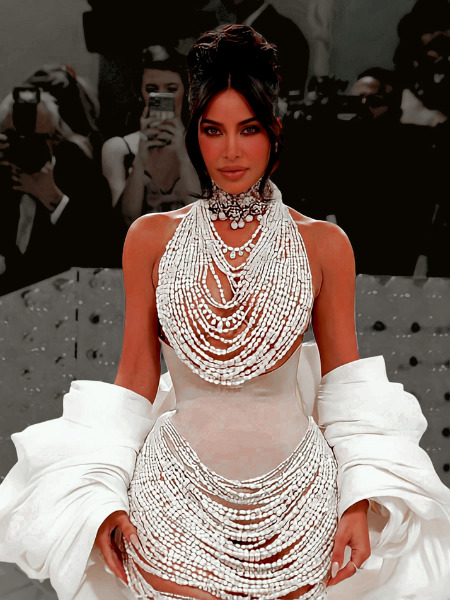

Mary Tyler Moore, Kim Kardashian, and Cher all have their tenth lords in Chitra. Others with this placement are Leonard Cohen, Mika, Diego Rivera, Bette Midler, Cesare Borgia, John Mayer, Leonardo Dicaprio, Paul Williams, Emily Dickinson, and Queen Elizabeth I.
Find it easy to engage with coworkers and members of the public as equals, both to yourself and to one another.
Experience the most professional and political epiphanies when everyone else is asleep, especially at three to four in the morning.
Strategize and organize your workspace as well as career and public events with ease and poise, to the satisfaction of all.
Can be stingy and thrifty with professional funding, and turn a critical eye upon those who insist on lax public spending, even if as an individual you practice generosity and charity.
May experience jealousy, or just suspicion, toward coworkers, public figures, or others in your field who remind you of yourself.
AND YOU MAY FIND…
Legacies play a role in the way that your workplace or public persona operates, such as becoming or gaining an apprentice, but you may find it hard to get on with those who inherit your position.
Bright colors, flowers, and natural beauty dominate your place of work, or settings with these attributes empower you publicly.
Others treat you with dignity and respect your aesthetic potential, even following your lead with the way you dress for events.
A quick temper and sensitivity to presentation inspires you to challenge the views or choices of others preemptively.
Intense procrastination hinders you in moments of specific importance.
CHITRA is the Star of Opportunity. Industries and career types favored are those involving aesthetics, communication, specialized expertise, design, dynamics, narrative, creative production, quality inspection, force of personality, precision, and reconstruction.
IF DHANISTHA RULES THE TENTH LORD…



Billie Joe Armstrong, Paris Hilton, and Lauren Bacall all have their tenth lords in Dhanistha. Others with this placement are Carl Sagan, Greta Garbo, Walt Whitman, Antony Armstrong-Jones, King Louis XV, Anna May Wong, Sarah Hyland, Charles Manson, and Liza Goddard.
Are capable of making highly insightful observations about society due to your keen perception and intimate understanding of power.
Had aspirations and politics shaped by a pragmatic altruism from a young age, perhaps in response to a parent or authority figure.
Feel uncomfortable in and experience adversity from business partnerships, and any relationships which are too public-facing.
Attract status and fame, seek positions of dignity, and approach tasks with a sincere desire to produce something of high quality.
Have no qualms about lying to or manipulating others in order to get what you want - and there is a great deal that you want.
AND YOU MAY FIND…
Even accomplishments celebrated in the public sector or by your industry feel hollow to you; the answer may lie in volunteer work.
Gender discrimination affects your workplace, status, or politics.
Popularity among certain demographics and subcultures: namely, the wealthy, the young, the politically liberal, and the creative field.
Any siblings can be of aid to your career and public image, but associating with extended relations may be detrimental to either.
Your experiences with honor or power - that of your own or that of others - affect you on a deep, even spiritual, level.
DHANISTHA is the Star of Symphony. Industries and career types favored are those involving music, timing, rhythm, quality inspection, physical performance, group coordination, property, strategy, math and science, poetry, spirituality, creativity, engineering, and charity.
HOPE THIS WAS HELPFUL. AMOUNT OF REQUESTS MEANS WE’RE GOING OUT OF ORDER, BUT WE WILL ABSOLUTELY RETURN TO THE OTHERS LATER. FEEL FREE TO MESSAGE WITH QUESTIONS, THOUGHTS, OR IDEAS. PART 5 WILL FOCUS ON JUPITER-RULED 10TH LORD NAKSHATRAS NEXT! ♡
#mars#10th house#midheaven#10th lord#vedic astrology#medium coeli#mrigashira#dhanishta#chitra#10th house lord#house lord#astrology#sidereal astrology#mine#natal chart#it's honstly so funny the ratio of male to female 10th house lord celebrities there are#like. on the nose much?#dhanishtha#nakshatra#nakshatras#authored#informal survey
134 notes
·
View notes
Text
❤️✧˚ ༘ ⋆The Synastry of Acts of Service & Being Taken Care of in a Relationship✧˚ ༘ ⋆❤️

❤️✧˚ ༘ ⋆❤️✧˚ ༘ ⋆❤️✧˚ ༘ ⋆❤️✧˚ ༘ ⋆❤️✧˚ ༘ ⋆❤️✧˚ ༘ ⋆❤️✧˚ ༘ ⋆❤️✧˚ ༘ ⋆❤️✧˚ ༘ ⋆
DISCLAIMER:
It's crucial to acknowledge that while astrology offers profound insights, every relationship is unique, shaped by the individuals involved, their experiences, and their choices. Astrology, in this context, provides us with a lens to better understand and appreciate the forces at work in our relationships. The concepts discussed in this article should not be taken as definitive or predictive of any specific relationship. Every relationship is unique, and its success depends on a multitude of factors, including communication, respect, and individual choices.
❤️✧˚ ༘ ⋆❤️✧˚ ༘ ⋆❤️✧˚ ༘ ⋆❤️✧˚ ༘ ⋆❤️✧˚ ༘ ⋆❤️✧˚ ༘ ⋆❤️✧˚ ༘ ⋆❤️✧˚ ༘ ⋆❤️✧˚ ༘ ⋆
Love and relationships are a beautiful interplay of emotions and actions that revolve around acts of service & taking care of one another. These acts form the foundation of a strong and nurturing partnership. In this post, we'll delve into the profound insights that show the dynamics of nurturing, being cared for, and experiencing acts of service in relationships. These elements not only enrich but also sustain the bonds between two individuals who have chosen to share their lives and hearts.
🌿The 6th House🌿
The 6th house is closely linked with daily routines, service, and health. In synastry, 6th house connections can show how partners experience love through practical and tangible ways. The small, often unnoticed acts of service that are essential for sustaining a relationship can be seen through this house. Additionally, it represents how partners support and take care of each other in their day-to-day lives.
• 6TH HOUSE PLANETS
When one partner's planets fall into the other partner's 6th house, it can indicate a sense of being loved and taken care of through acts of service and practical support. For example, if one person's Moon falls into their partner's 6th house, they may feel cherished by their partner's attentiveness to their emotional needs.
If 6th house connections are prominent, it can suggest that the foundation of the relationship is built on mutual service, care, and support. Both partners may feel loved through the shared responsibility and attention to each other's needs.
Remember that the planet person is the one bringing the energy forth, and the house person is usually the receiver. The roles can switch, though!
🌕 The Moon 🌕
The Moon represents our emotional needs and the way we nurture and are nurtured in relationships. Ultimately, Moon connections in synastry can indicate if the emotional needs of both individuals are in sync or complement each other.
MOON CONJUNCTION
If your Moons are conjunct (in the same sign), you may feel deeply nurtured by the emotional bond you share. This aspect often leads to a sense of emotional fulfillment and being taken care of because your needs are so similar. In other words, you have a natural inclination to nurture and care for each other in the same way. You may also find comfort and a sense of home in each other's presence.
MOON OPPOSITION
Moon oppositions may bring some challenges, but they can also create a strong magnetic pull. Partners may take turns nurturing each other. Their opposing emotional styles can initially create some challenges in understanding and connecting with each other on an emotional level. For instance, Part A has a Pisces Moon while Partner B has a Virgo Moon. If Partner A is feeling overwhelmed by their deep emotions, Partner B's practical and analytical nature can provide a grounded perspective and practical solutions to emotional issues. On the other hand, Partner A's intuitive and empathetic nature can help Partner B open up emotionally and connect with their own feelings.
MOON TRINE & SEXTILE
Moon sextiles and trines indicate emotional harmony and ease. Partners who share these aspects often have a natural flow of emotional care and support. This dynamic makes it natural for them to understand and support each other's emotional needs. Moon trines, like Moon sextiles, indicate emotional ease. For example, Moon trine Moon aspects enhance the depth of emotional understanding between partners. It can also indicate that they have an innate ability to tune into each other's feelings and provide emotional support without much effort.
🪐Saturn🪐
Saturn is associated with structure, responsibility, commitment, and stability. In synastry, it plays a significant role in shaping the level of duty each partner feels toward the other and the commitment they are willing to invest in the relationship. The Saturn person is usually the one taking care of the planet person, though the roles can switch!
• SATURN CONJUNCTIONS
When one partner's Saturn is conjunct a partner’s planet or a crucial point (such as the Sun, Moon, or Ascendant) in their partner's chart, it can create a strong sense of responsibility and commitment. Acts of service in this context often revolve around building a secure future together. For example, if Partner A's Saturn conjuncts Partner B's Moon, they help Partner B become emotionally mature, and they tangibly take care of their need for safety through acts of service.
• SATURN OPPOSITIONS
Saturn oppositions can bring challenges related to sharing responsibilities and authority in the relationship, but they also provide opportunities for growth. The partners may find themselves taking on shared responsibilities and learning to navigate issues together. The Saturn person usually has the most responsibility. Moreover, Saturn oppositions can also create a sense of being taken care of through shared lessons and responsibilities a couple faces together. They may appreciate that they are helping each other grow and mature, even if it's not always easy.
• SATURN TRINES & SEXTILES
These aspects indicate that both partners can excel in working together to achieve long-term goals. There’s mutual support and shared responsibilities that promote stability. Saturn trines or sextiles in synastry often bring cooperation and a sense of ease when working together towards long-term goals. Partners may share tasks and commitments in a way that promotes stability and balance. This can include financial planning, household duties, or even working together on professional projects.
• SATURN’S HOUSE
The house placement of one partner’s Saturn into the other partner’s birth chart signifies a sense of responsibility and commitment related to the themes of that house. For example, if one person's Saturn falls in their partner's 3rd house of finances and possessions, they may feel loved through their partner's words of affirmation, love letters, kind text messages, etc.
🫀Venus & Jupiter🫀
Venus in synastry can show how partners spoil each other with acts of love and kindness. A partner’s Venus sextile, trine, or conjunct the other partner’s planets (Sun, Moon, Jupiter, Venus, Ascendant) can indicate that they indulge each other with romantic gestures and expressions of love. The Venus person is usually the one indulging in kind acts of service, though the roles can switch.
Jupiter has a similar role, representing generosity and indulgence within relationships. A partner’s Jupiter sextile, trine, or conjunct the other partner’s planets (Sun, Moon, Venus, Jupiter Ascendant) can indicate a sense of shared growth and abundance in the relationship. The Jupiter person is usually the one being generous and benevolent towards the planet person, though the roles can switch.
❤️✧˚ ༘ ⋆❤️✧˚ ༘ ⋆❤️✧˚ ༘ ⋆❤️✧˚ ༘ ⋆❤️✧˚ ༘ ⋆❤️✧˚ ༘ ⋆❤️✧˚ ༘ ⋆❤️✧˚ ༘ ⋆❤️✧˚ ༘ ⋆
Thank you for taking the time to read my post! Your curiosity & engagement mean the world to me. I hope you not only found it enjoyable but also enriching for your astrological knowledge. Your support & interest inspire me to continue sharing insights & information with you. I appreciate you immensely.
• 🕸️ JOIN MY PATREON for exquisite & in-depth astrology content. You'll also receive a free mini reading upon joining. :)
• 🗡️ BOOK A READING with me to navigate your life with more clarity & awareness.
❤️✧˚ ༘ ⋆❤️✧˚ ༘ ⋆❤️✧˚ ༘ ⋆❤️✧˚ ༘ ⋆❤️✧˚ ༘ ⋆❤️✧˚ ༘ ⋆❤️✧˚ ༘ ⋆❤️✧˚ ༘ ⋆❤️✧˚ ༘ ⋆
#aquarius#aries#astro community#astro observations#astrology#astrology signs#cancer#capricorn#gemini#horoscope#astrology community#zodiac#astrology compatibility#synastry astrology#synastry#astro posts#astro notes#astrology placements#astro placements#synastry overlays#synastry aspects#synastry chart#astrology blog#natal chart#birth chart
197 notes
·
View notes
Text
THEME: Fuck WotC
With the updates to the OGL, you might be looking for a way to play your fantasy game without having to worry about supporting a company that doesn't hold the interests of the community as a priority. These series of recommendations are specifically about exploring dungeons in settings that might possibly have dragons, and require little to no time, effort, or money given towards Wizards of the Coast. Moreover, most of these games heavily encourage home-brew, rule hacks, and your own custom creations!




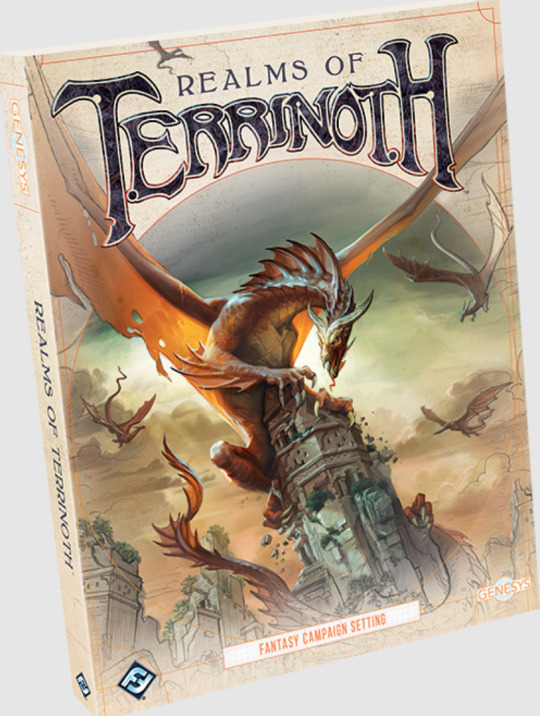


Ironsworn, by Shawn Tomkin.
In the Ironsworn tabletop roleplaying game, you are a hero sworn to undertake perilous quests in the dark fantasy setting of the Ironlands.
Others live out their lives hardly venturing beyond the walls of their village or steading, but you are different. You will explore untracked wilds, fight desperate battles, forge bonds with isolated communities, and reveal the secrets of this harsh land.
Are you ready to swear iron vows and see them fulfilled—no matter the cost?
Ironsworn is majestic. Character motivation is built in during creation, so you start the game knowing something about who your character is and what they want - and from the very beginning, your character’s story is vital to the campaign. You can approach problems from a number of different approaches, including combat, persuasion, physical prowess, and more.
The game is built for solo, co-op, and guided play. This means that if you have a friend who’s willing to GM, they have plenty of help in coming up with plot. If you have no-one who’s willing to GM, you can still play the game - and if you have no-one who’s willing to play the game with you, you can still play it. Finally, and this might be the best part: Ironsworn, a 270-page PDF full of lore, advice and foes… is free.
DURF, by Emil Boven.
DURF is a rules-light dungeon-fantasy RPG in the vein of games like Knave, Troika! and Into the Odd. When it comes to character background, appearance, and history, much of what you decide will be up to you: your character backstory doesn’t have to influence your stats if you don’t want it to. Your character’s stats are boiled down to three: Strength, Dexterity, and Willpower, and you have an inventory of 10+ your Strength. The game is rules-light, but the rules that are there make combat similar to what you see in D&D: you have to roll higher than your opponent, account for range, and most rolls depend on a d20.
Spell casting isn’t limited to specific classes in DURF, because there aren’t any specific classes. However, that doesn’t limit what your character can do to grow. You can increase character stats, add new spells, and consult a trove of content for this game created by people who love it, much of which is either free or incredibly reasonably priced! If you find yourself writing a lot of your own content for your D&D game anyways, you might enjoy the really creative community that’s popped up around DURF and similar OSR games.
World of Dungeons, by John Harper.
World of Dungeons is a simple, quick-play, dungeon crawling game, using one of the core mechanics from the Powered by the Apocalypse rules system. It's compatible with Old School Renaissance and original D&D monsters, dungeons, and adventure modules.
This is another game that doesn’t require a lot of dedication to convert what you know and are comfortable with into a new system. It’s also an introduction to the standard PbtA conceit of rolling 2d6 for every action and a three-tiered level of success that moves the plot forward, even if you fail. Failure in PbtA games can be just as interesting and engaging as successes - and once you’ve got the hang of this mechanic, there’s a whole world of games available to you!
Tunnel Goons, by Nate Treme (Highland Paranormal Society).
Tunnel Goons is a simple table-top role-playing game. It was originally only included in the zine The Eternal Caverns of Urk. It's a light weight 2d6 system that can be applied to many different genres and settings.
An extremely streamlined system, Tunnel Goons is only 4 pages long and is pay-what-you-want. You only need d6’s to play, and have three stats to take care of. If you enjoy roleplaying but find the idea of transferring to a new system daunting, you pick up a game of Tunnel Goons to try out something new without having to learn a bunch of new rules or spending a lot of money.
This game is small and simple, but it’s also been hacked a number of times for many different genres, which means that if what you like about roleplaying is coming up with new settings and new character options to play with, you’re right at home here!
Realms of Terrinoth, by Fantasy Flight Games.
Terrinoth is a land of forgotten greatness and lost legacies. Once ruled by the Elder Kings who called upon mighty magics to perform great deeds and work marvels, the land has suffered greatly at the hands of its three great foes: the undead armies of Waiqar the Betrayer, the demon-possessed hordes of the bloodthirsty Uthuk Y’llan, and the terrifying dragons of the Molten Heath. Many of its great cities have been cast down into ruins, and many wondrous secrets and powerful artifacts have been lost.
For hundreds of years, Terrinoth slipped into gloom and decay. But heroes arise just when their lands need them the most. Courageous adventurers brave the ruins of past ages and the foul creatures within to uncover the treasures of their ancestors. The Daqan Barons, inheritors of the ancient kingdoms, rebuild their walls and muster their armies, while the wizards of Greyhaven gather runes of power to awaken guardians of stone and steel. These preparations come none too soon, for the ancient enemies of the lawful races are stirring again, and Terrinoth needs champions of courage and cunning to stand against the rising darkness.
If what you like about D&D is the collection of options and stat-block builds that you can lovingly craft, the Genesys system that runs Realms of Terrinoth has plenty of options that help you build your own backgrounds and create your own classes. So if the setting doesn’t have what you’re looking for, it can’t stop you! The dice system is fundamentally different in that the dice don’t have numbers on them at all - they provide you with successes, failures, advantages and threats, which means that it’s possible to succeed and also running into obstacles, as well as fail and still experience a boatload of good luck! This is the only game on this list that isn't an indie game.
Cairn, by Yochai Gal.
Cairn is an adventure game for one facilitator (the Warden) and at least one other player. Players act as hardened adventurers exploring a dark & mysterious Wood filled with strange folk, hidden treasure, and unspeakable monstrosities.
Based on Knave by Ben Milton and Into The Odd by Chris McDowall, Cairn is an attempt at making Into The Odd semi-compatible with popular OSR settings like Dolmenwood. Character generation is quick and random, classless, and relies on fictional advancement rather than through XP or level mechanics. The game itself is rules-light but functional, leaving most rulings up to the Warden.
Cairn is an excellent example of how creative and generous the indie ttrpg community is, especially within the OSR scene. A free rulebook, it is designed to be used alongside other popular games in the OSR scene, and has many of its own adventures designed by the community. These kinds of games are wonderful for players who are excited about exploring fantastical and dangerous places, and solving the variety of problems that appear within.
Blades in the Dark, by John Harper.
Blades in the Dark is a tabletop role-playing game about a crew of daring scoundrels seeking their fortunes on the haunted streets of an industrial-fantasy city. There are heists, chases, occult mysteries, dangerous bargains, bloody skirmishes, and, above all, riches to be had — if you’re bold enough to seize them.
You and your fledgling crew must thrive amidst the threats of rival gangs, powerful noble families, vengeful ghosts, the Bluecoats of the city watch, and the siren song of your scoundrel’s own vices. Will you rise to power in the criminal underworld? What are you willing to do to get to the top?
Blades in the Dark is a setting that has amassed a large following for a number of reasons: it has free player resources, it prioritizes fiction-first gaming, it has a tight set of rules that are easy to learn and expand upon, and the setting fucking slaps. It’s the parent of the entire Forged in the Dark family of games, so if you don’t want to play criminal masterminds in an industrial city - you don’t have to! There’s so many games published under this ruleset that fall under different themes, such as Band of Blades, a military fantasy setting, Into the Dark, a dungeon-delving game, and Blades Against Darkness, a game about adventurers exploring tombs and new frontiers. FitD games provide a tight setting and focus for your group, so you’ll always know what your players are working towards, and there are number of interlocking systems that you can pull on to increase your chance of success - at the risk of pushing your character a little closer to stress and trauma.
If you want something that's not high-fantasy dungeon delving -well, that's what the rest of my blog is for!
#dnd#dungeons and dragons#high fantasy#game recommendations#indie ttrpgs#tabletop games#wizards of the coast#wotc
768 notes
·
View notes
Text
"While mainstream media increasingly cover violence and legislative attacks against trans people, many scholars and activists worry that focusing just on violence and discrimination fails to capture the full experience of being trans.
Drawing on the success of movements like the Black Joy Project, which uses art to promote Black healing and community-building, trans activists are challenging one-dimensional depictions of their community by highlighting the unique joys of being transgender.
My research on trans parents affirms the reality of trans joy. From 2019 to 2021, I interviewed 54 transgender women — both current and prospective parents — from diverse racial and class backgrounds across the country.
I found that while many have navigated discrimination in their parenting journeys, they also have fulfilling parent-child relationships, often with the support of partners, families of origin and their communities.
Gender euphoria
Scholars and community members use the term gender euphoria to describe a “joyful feeling of rightness in one’s gender/sex.”
It diverges from the diagnosis of gender dysphoria, or a sense of conflict between assigned sex and gender identity typically associated with feelings of distress and discomfort.
Gender euphoria celebrates feeling comfortable with who you are and how you are perceived by the world.
Some people transition with a specific set of goals, while others discover new sources of joy and new facets of their identity over time.
Many of the trans women I interviewed expressed their gender euphoria in relation to their role as mothers. A Black trans woman in her 20s, whom I will call Gloria, experiences joy in being recognized as a mother.
“I love being called Mom. That’s the greatest thing,” she told me. “I love waking up every morning to see [my child’s] beautiful face. It keeps me motivated.” ...
For many trans people, transitioning opens up a new set of possibilities. When I asked Adriana, a trans Latina in her 30s, what it was like to come out as trans, she told me,
“I’ve never been happier. The happiest day of my life was when my daughter was born, and the second happiest day of my life was when I [started transitioning].”
Family and community connections
While some trans people do experience rejection from their families of origin, that is not true for the majority of the community.
In a 2015 national survey of over 27,700 trans adults, the U.S. Trans Survey, 60% of respondents reported having families who are supportive of their trans identity.
Trans women also form chosen families with friends, co-workers and other community members. Relationships with other trans people can have particularly positive effects on identity development and overall well-being, including emotional resilience, self-acceptance and a sense of connection.
Trans community care
In addition to caring for their biological and adopted children, the trans women I interviewed felt a responsibility to take care of their community.
Sometimes this care manifested as parent-child relationships, in which respondents provide financial or emotional support to LGBTQ+ youth.
Maggie, a white woman in her 50s, didn’t know she was a parental figure for her “queer kids” until they tagged her on Instagram to celebrate Mother’s Day.
“Someone might go, ‘Hey, can I stay on your sofa tonight? I’m having a hard time.’ Well, yeah, of course,” she said.
“Or they might hang around the shop [I work at], and only later it dawns on me, ‘Oh, this was the only place they could come and get affirmed and not feel weird.’” ...
Miriam, a white trans woman in her 60s, agreed that she has a lot to learn from younger trans people.
“A lot of my community today, people who I count as family and my beloveds, are not of my generation,” she said. ‘Beloveds’ is the term she uses to describe her platonic loved ones.
“I learn a lot from my beloveds in their 20s and 30s, who don’t have the same baggage I [dealt with] about how I could be and who I could be.”"
-via GoodGoodGood via The Conversation, July 14, 2023
#trans#transgender#transphobia#transmisogyny#lgbtq youth#queer elders#trans women#transfeminine#trans is beautiful#trans pride#gender dysphoria#gender euphoria#chosen family#good news#hope#hope posting#trans joy
250 notes
·
View notes
Text
In defense of Huntlow
A love letter to Dana and the Owl Crew
Recently, I have been witnessing an increase in anti-Huntlow rhetoric on Tumblr, which I originally ignored, knowing how intense shipping wars can be.
Earlier today, however, I came across a very inflammatory post accusing Dana and the crew of bad - if not intentionally hurtful - writing for seemingly leaning towards making the ship canon.
As an ace, demiromantic lesbian who deeply cares about queer representation in media, I decided to share some thoughts on the matter, by addressing and hopefully debunking the main accusations I have seen out there.
I. A deliberate jab at the aspec community
Due to the dreadful lack of representation in mainstream media, many aspec viewers, myself included, headcanon Hunter as being somewhere on the spectrum.
Some erroneously believe that Hunter’s obvious crush on Willow invalidates this understanding of his character, and have even gone as far as to imply that the writing team deliberately deprived them of representation - ignoring the fact that Hunter’s arc was most likely fully fleshed out long before he was introduced to the fandom.
The thing is, we do get canon representation in the form of Lilith, who might be willing to boogy down to history town, but definitely isn’t willing to boogy down with you or anyone else for that matter. And let me tell you, she is *great* representation - a complex character who is in no way demonised or infantilised.
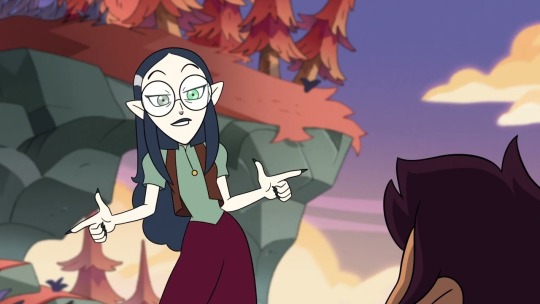
Additionally, and perhaps even more importantly, Hunter’s crush does *not* negate his belonging to the spectrum - key word here being *spectrum*. He might not fit the specific label you had in mind, but that’s alright - remember we come in all shapes and sizes!
II. Pushing a queer ship out of the spotlight
The argument here is that Huntlow has been distracting both the audience and the narrative itself from Lumity, an explicitely queer relationship that has been providing groundbreaking representation in the otherwise desperately heteronormative world of kids’ television.
I’ll be honest - I don’t really understand where this comes from. Huntlow might have been getting more fanart and fanfic lately due to the novelty factor, but in no way does this pose a credible threat to Lumity, which absolutely remains the main focus on the show as well as the most popular ship in the fandom ( in fact, most TOH artists seem to ship both pairings! ).
As of now, Huntlow is nothing more than a one-sided teenage crush, while Lumity has been getting in-depth development throughout season 2, culminating in their iconic kiss - I’m sure the team had to fight very hard for this scene to stay in, so let’s show some appreciation!

Interestingly, Raeda also benefited from the novelty factor when it was first introduced, and didn’t receive *nearly* as much backlash. The reason for this difference in treatment? Raeda is an explicitly queer ship.

And the thing is, in a series with so much representation, Huntlow might very well turn out to be as well ( cf point 1 ) ! There is a longstanding bias in the LGBTQIA community against « straight-passing » relationships and people who do not look « queer enough ». In all likeliness, we won’t get any confirmed labels for these two ( which is *fine* - they are kids! ), but it would be very interesting if the show actually took us down that road and forced us to confront our own biases.
( Also, people are allowed to be cishet. But that is not my point here. )
III. Underdevelopment and « bad writing »
As a RWBY veteran, I have grown used to Bumbleby-antis claiming the ship overtook the plot while paradoxically getting no development. This flawed logic seems to be repeated here, so let’s explore a couple of possibilities.
Personally, I would prefer Hunter and Willow’s relationship to stay as it is as of the end of season 2 - celebrating the important role first crushes can play in shaping one’s identity, even though they might never lead to any concrete romantic fulfillement. But, in the very likely occurrence that something *will* happen between these two, there is plenty of material to back them up.
A. Lumity parallels or the tomato syndrome
Some argue that Huntlow lacks development because all we’ve seen so far is one-sided blushing on Hunter’s part - completely overlooking the fact that this is exactly how Lumity started out!

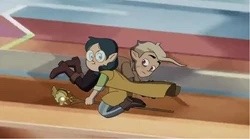
The parallels do not stop there, however, as many excellent posts have pointed out. Both Amity and Hunter grew up in physically and emotionally abusive households, and connecting with their respective crushes helped them gain a new understanding of the world. In his « Captain », Hunter has found a person he can experience healthy admiration for, something that is also significant for Willow who has a history of being overlooked and underestimated.
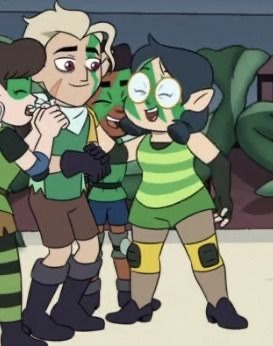
In fact, one might even argue that Amity predicted Hunter’s crush - remember that one scene in Eclipse Lake? This is great foreshadowing!
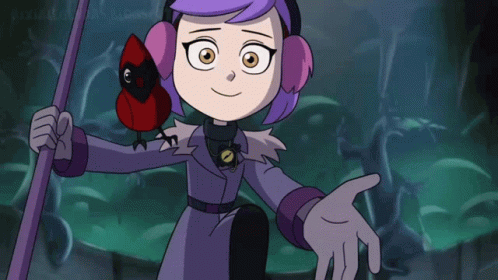
B. Caleb parallels or the radical act of love
Now that we know more about Belos’ backstory, a key theme of the show is starting to emerge: love as a vector of rebellion, freedom and systemic change - a message that the LGBTQIA community as a whole is very familiar with.
While Hunter and the previous Golden Guards are all unique individuals with a mind and heart of their own, the fact that every single one of them ultimately chose to rebel against Belos is a strong sign that Caleb’s influence has persisted throughout the centuries. And what was Caleb’s biggest crime, exactly?
Falling in love with a witch.

The point here is not that Hunter is condemned to fall in love with a witch himself by virtue of being a clone with no agency of his own. It’s that Caleb’s hardships and bravery in the face of bigotry opened the door for him to proclaim his own independence through the radical act of embracing a form of love that the powers in place deem demonic and unnatural.
And what an amazing message to send out to a young audience.
IV. But… But the age gap is predatory!!!
I might be gay, but I can still do Maths. So let’s do just that.
Hunter is canonically 16. I don’t believe Willow’s age is ever outright stated in the series, but I assume she is around Luz’s age. Had it not been for Disney being, you know, Disney, our girl would have celebrated her quinceañera in season 3, so we can extrapolate that at this point in the story, Willow is around 15 as well.
That’s a one-year difference. Come on, guys.
Final thoughts: maybe stop being mad about everything all the time
Look guys, I get it, I really do. We have all been starving for queer content our entire lives, so when we finally get it, we expect it to match every single one of the expectations we’ve been desperately holding on for so long.
But the thing is, harassing a queer creator who is fighting tooth and nail to provide kids with life-changing ( and potentially life-saving ) representation is only going to hurt us further.
Use this energy to write fanfic, draw fanart, create a story that will inspire others the way this show does for so many of us. Campaign for more representation in media. Question your own biases and be a little kinder to one another.
And, most importantly - watch The Owl House!

#the owl house#toh#toh spoilers#dana terrace#the owl crew#hunter toh#willow park#huntlow#luz noceda#amity blight#lumity#eda clawthorne#raine whispers#raeda#lilith clawthorne#emperor belos#belos#philip whittebane#caleb whittebane#evelyn clawthorne#lgbtqia representation#character analysis#plot analysis#shipping wars#random ramblings#Thank you Tumblr for making the formatting literal Hell!#Unfortunately I am tougher and smarter than you#And thank you @dragongutsixofficial for reviewing this for me 💖
2K notes
·
View notes
Note
In the realm of video game fandom, the devoted following of Baldur's Gate 3 has illuminated intriguing facets of player engagement, particularly in the narrative arc of Astarion. As players guide Astarion through his quest, a subset of fans has garnered attention for their response to the character's journey towards ascension. In exploring the dynamics of this fandom, it becomes apparent that some individuals within the community seem inclined to perpetuate notions of toxic masculinity and homophobia/panphobia. Their fervent desire to pigeonhole Astarion into a heteronormative lifestyle not only raises questions about the broader implications of player agency but also invites a critical examination of the intersection between virtual narratives and societal norms within gaming culture. In this essay I will...
Lmfao I mean when you're right you're right. I think in general the "Astarion has an insane fandom" stuff is wildly overblown because really it's just the extremes being Really Loud and most people, but the kind of fan I've observed in the larian forums just honestly baffles me.
I'm not talking about AA fans. I'd honestly say most of the AA fans are normal too, so I definitely don't mean the ones who just *like* him. I'm talking about the highly specific subset who think there's this giant larian conspiracy to target AA fans and spite them specifically, release updates to change Astarion's personality because they hate Astarion as a character and dont want him to be his "real" self, etc. It's so weird.
I thought I was done talking about them but then the kisses update happened and they're in full force on the forums and official larian discord spamming "feedback" that the expressions for tav/durge need to be changed. The stuff I've read in their threads really solidifies that they think Astarion is meant to be this hyper masculine provider fantasy for them and his spawn self is just a stepping stone to get to that wish fulfillment (they won't accept his spawn self because he's "weak" and "pathetic" ie not masculine enough for them). At this point I'm just wondering why they're still around because it's very obvious they don't like Astarion as a character or what his story can say, they just want him to fulfill this bizarre toxic role they've constructed for him.
62 notes
·
View notes
Text
The Writer’s Guide To Creating Animal Companions
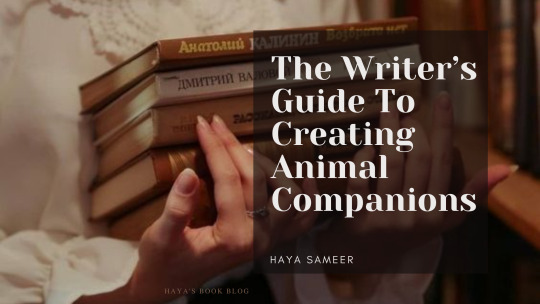
Animal companions have played an essential role in countless stories. From loyal dogs to mystical creatures, these furry or feathered friends have added depth to characters and narratives, leaving a lasting impact on readers. As a writer, understanding how to create and utilize animal companions can be a powerful tool in your storytelling arsenal.
So, if you’re looking to create an animal companion for your character, here is my comprehensive guide for everything you need to know when writing animal companions.
Do You Need to Have an Animal Companion?
When deciding whether to include an animal companion in your story, it's essential to consider the narrative and thematic elements at play. The presence of an animal companion can significantly impact the storytelling experience, and it's essential to ensure it aligns with your narrative objectives. Here are some scenarios where having an animal companion can be particularly appropriate:
Enhancing Character Relationships: Animal companions can deepen the connections between characters. For example, in J.K. Rowling's "Harry Potter" series, Harry's snowy owl, Hedwig, serves not only as a beloved companion but also as a means for Harry to communicate with the wizarding world. Hedwig's presence strengthens Harry's character and relationships.
Symbolism and Metaphor: In literature, animal companions are often used symbolically to represent themes, traits, or personal growth. For instance, in George Orwell's "Animal Farm," the animals on the farm symbolize different aspects of society and politics.
Emotional Support: Animal companions can provide emotional support and serve as a source of comfort for characters, particularly in challenging or lonely situations. Think of Samwise Gamgee's unwavering devotion to Frodo in J.R.R. Tolkien's "The Lord of the Rings."
Plot Advancement: Animal companions can become instrumental in advancing the plot, offering unique abilities, perspectives, or assistance that the human characters lack. Consider the role of Toto in L. Frank Baum's "The Wizard of Oz," who often aids Dorothy on her journey.
Thematic Consistency: In some stories, the inclusion of animal companions is necessary for thematic consistency. If your narrative explores themes related to the environment, animal rights, or the bond between humans and nature, animal companions can be integral to reinforcing those themes.
By integrating an animal companion that aligns with your narrative and thematic objectives, you can create a more engaging and immersive reading experience for your audience. Keep these considerations in mind when making your decision.
Choosing the Right Animal
Once you've established the narrative and thematic reasoning for including an animal companion, the next step is to select the right creature to fulfill that role. Here are some factors to consider when choosing your animal companion:
Relevance to the Story: The chosen animal should have a direct or symbolic relevance to the story. Consider how the animal's traits, behaviors, or symbolism align with the narrative purpose. For example, a story centered on the theme of freedom might feature a soaring eagle as an animal companion.
Character Compatibility: The animal companion should complement or contrast with the character it accompanies. Think about how the animal's personality or abilities can enhance or challenge the character's journey. A timid character might be paired with a bold and protective animal, creating an interesting dynamic.
Unique Qualities: Select an animal with distinctive qualities that set it apart from generic pets. It could be an uncommon species, a creature with magical abilities, or a hybrid of animals. These unique qualities can add depth and intrigue to your story.
Practicality: Think about the practical role the animal companion will play in the story. If your narrative requires the animal to perform specific tasks, ensure that the chosen creature is suited for those roles. For instance, a hunting dog might be essential in a survival adventure.
Symbolic Significance: The animal companion's symbolism can be a driving force in the story. Consider how the animal represents themes, emotions, or concepts important to the narrative. A black cat might symbolize mystery and superstition in a story set in a quaint village.
Emotional Connection: As an author, aim to create an emotional connection between readers and the animal companion. Whether through endearing quirks, heartwarming moments, or shared challenges, the bond between the character and their animal should evoke feelings in the audience.
Research: Invest time in researching the chosen animal, understanding its behaviors, needs, and characteristics. Accurate portrayal of the animal can enhance your story's realism and resonance. Whether it's a fierce predator or a gentle pet, knowing your animal inside out is essential.
Cultural and Mythological Significance: Some animals carry cultural or mythological significance that can add depth to your narrative. Explore how certain animals are perceived in different cultures and mythologies and consider weaving these interpretations into your story.
Choosing the right animal companion is a critical decision that can greatly impact your narrative. By considering these factors, you can ensure that the animal complements your characters and story, enriching the overall experience for both your characters and readers.
Portraying and Developing Your Animal Companion
Once you've selected the ideal animal companion for your story, it's essential to portray and develop them effectively. Your readers should connect with the animal on a personal level and feel invested in their journey. Here are some key aspects to consider:
Character Development: Treat your animal companion as a fully developed character. Just like any human character, the animal should have a backstory, quirks, motivations, and a character arc. Whether it's a loyal friend, a protector, or a guide, their growth and transformation should be evident throughout the narrative.
Show Their Personality: Give your animal companion a distinct personality. Think about their likes, dislikes, fears, and preferences. Are they mischievous, stoic, or curious? The animal's personality traits should shine through their actions and interactions with other characters.
Dialogue and Communication: While animal companions may not speak human languages, they can still communicate. Use non-verbal cues, body language, and noises to convey their thoughts and emotions. An attentive reader will pick up on these cues to understand what the animal is trying to express.
Bond with the Protagonist: Highlight the unique bond between the animal companion and your main character. This connection should be palpable, with mutual trust, loyalty, and emotional support. Readers should feel the strength of this relationship, making them emotionally invested in the animal's welfare.
Purpose and Impact: Ensure that the animal companion has a clear purpose within the story. Their presence should contribute to the plot's development, whether by assisting the protagonist, creating conflict, or acting as a symbolic element. Avoid including the animal just for the sake of it; they should serve a meaningful role.
Growth and Challenges: Like any character, the animal companion should face challenges and obstacles. These experiences can lead to character growth and development. Whether it's overcoming fears, learning new skills, or deepening their connection with the protagonist, their journey should be dynamic.
Readers' Emotional Connection: Use your animal companion to evoke emotions in your readers. Their well-being or safety can become a source of tension and concern for the audience. Whether it's a heartwarming moment, a daring rescue, or a bittersweet farewell, these emotional elements can leave a lasting impact.
Realism and Consistency: Ensure that the portrayal of your animal companion is consistent with their species and behavior. Be mindful of realistic attributes and instincts. It's crucial to balance anthropomorphism (attributing human characteristics to animals) with authenticity.
Symbolism and Themes: Leverage the animal companion to reinforce themes or symbolism in your narrative. Consider how their actions and characteristics align with the broader messages of your story. This adds depth and layers to the storytelling.
By developing your animal companion as a fully fleshed-out character and maintaining consistency in their portrayal, you can create a powerful and engaging narrative. Readers should find themselves emotionally invested in the fate and experiences of your animal companion.
Challenges and Common Pitfalls in Writing Animal Companions
While animal companions can enhance your storytelling, they also come with potential challenges and common mistakes. It's important to be aware of these pitfalls to ensure your animal companion is a valuable addition to your narrative. Here are some common issues to watch out for:
Stereotypes and Clichés: One common pitfall is relying on stereotypes or clichés when developing animal companions. Avoid making them overly predictable, such as portraying all dogs as loyal and all cats as aloof. Instead, give your animal companion unique traits and behaviors that break free from these molds.
Lack of Individuality: Failing to give your animal companion a distinct personality can lead to them feeling one-dimensional. Each animal, even within the same species, should have its own quirks and characteristics. Make them memorable and unique.
Inconsistent Behavior: Maintaining consistency in your animal companion's behavior is crucial. Avoid having them act unpredictably or against their natural instincts. Any sudden changes in behavior should be justified within the story.
Overemphasizing Anthropomorphism: While anthropomorphism can be used to convey the animal's emotions and intentions, overdoing it can make the character seem unrealistic. Strive for a balance between human-like qualities and authentic animal behavior.
Underdeveloped Bond: Failing to establish a strong bond between your protagonist and their animal companion can undermine the emotional impact of their relationship. The connection should be evident through interactions, trust, and mutual understanding.
Neglecting Character Growth: Just like human characters, animal companions should experience growth and development throughout the story. Neglecting their character arc can lead to missed opportunities for emotional depth.
Unexplained Abilities: If your animal companion possesses unique abilities or characteristics beyond their species norm, provide a plausible explanation within the narrative. Readers appreciate when these traits are justified and integrated into the story's world-building.
Neglecting Consequences: Consider the consequences of your animal companion's presence in the story. Their actions should impact the plot and other characters. Failure to address these consequences can lead to plot holes.
Ineffective Use: Don't introduce an animal companion if they serve no significant purpose in the story. Every character, including animals, should contribute to the narrative's development.
Sacrificial Companions: While dramatic and emotional, the trope of the sacrificial animal companion should be used sparingly and meaningfully. Overusing it can become predictable and lose its impact.
Avoiding these common pitfalls and challenges ensures that your animal companion remains a compelling and integral part of your narrative. By giving them depth, individuality, and a meaningful role, you can create a character that resonates with your readers.
I hope this blog on The Writer’s Guide To Creating Animal Companions will help you in your writing journey. Be sure to comment any tips of your own to help your fellow authors prosper, and follow my blog for new blog updates every Monday and Thursday.
Looking For More Writing Tips And Tricks?
Are you an author looking for writing tips and tricks to better your manuscript? Or do you want to learn about how to get a literary agent, get published and properly market your book? Consider checking out the rest of Haya’s book blog where I post writing and publishing tips for authors every Monday and Thursday! And don’t forget to head over to my TikTok and Instagram profiles @hayatheauthor to learn more about my WIP and writing journey!
#hayatheauthor#haya's book blog#haya sameer#haya blogs#writers on tumblr#writer community#writer tools#writer blog#writer stuff#writer wednesday#writer tips#creative writing#writers of tumblr#writerscommunity#writeblr#writing community#writer spotlight#writer things#writing prompt#writing tools#writing stuff#writing#writing life#writing inspo#writing help#writing advice#writing inspiration#writing ideas#writing things#writing tip
121 notes
·
View notes
Note
So...Thoughts on the whole people thinking Sylvie is Aro-Ace? I can kinda see her being Aromantic, but with her mentioning she's more "hedonistic" than Loki and silently hinting that she's Bi too, can't really see her as Asexual. But what do you think?
LET'S TALK ABOUT SYLVIE'S SEXUALITY, HER RELATIONSHIPS WITH LOKI AND MOBIUS, & HER CONTRIBUTIONS TO THE SERIES NARRATIVE
Before I answer this, I think it's important to acknowledge that fictional characters exist for people's comfort and pleasure. I write original fiction, and I would hope that most artists believe in the right of the audience to interpret character to meet their personal needs. To me, canon is a sandbox. Everyone should play with it as they please and not hate on each other. There are more important things in life to worry about. Therefore, if Sylvie reads as Aro-Ace to you and that reading brings you joy, then she is.
This question inherently requires the need to talk about Sylki in this post. I predominantly analyze Lokius, so please, no hate! My number one rule is never yucking someone's yum. Furthermore, Sylvie plays a critical role in Loki's development and the philosophical thrust of the series, of which Mobius also contributes to as the other half of Loki's character arc equation (selflessness and sparing life [Mobius] + free will and revolution [Sylvie]). It would be biased and disingenuous to not acknowledge her contributions to the overarching narrative.
ARO-ACE INTERPRETATION
All right, your question! I can definitely can see Sylvie as being aro-ace. That's a legitimate interpretation based on how she responds to Loki's flirtation and romantic advances. It is also possible that she's an aromantic bisexual. This second possibility is more likely based on the text the audience is given.
THE CANON TEXT
Having said that, I think you're curious about what the source material is trying to say about Sylvie's character and how that influences her sexuality. I believe it's important to remember that external behavior doesn't dictate how someone defines themselves. Closeting and disengagement from intimacy because of trauma are prime examples of this.
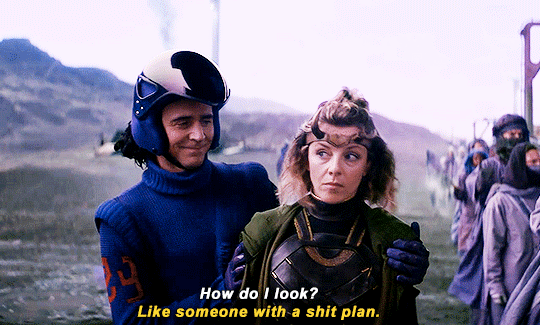
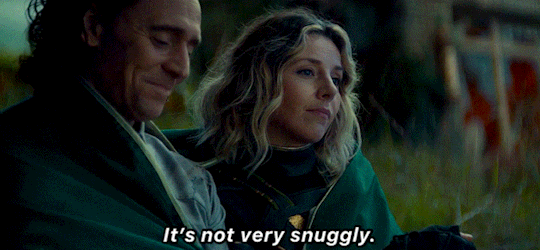
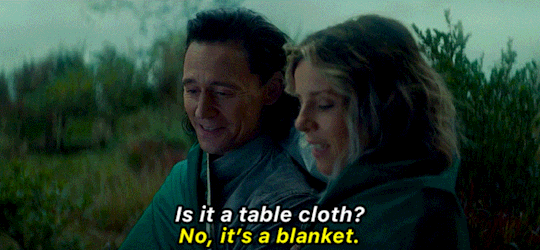
The train scene in S1E4 reads as earnest. Loki and Sylvie are both very lonely characters. In this moment, both are trying to connect with someone who finally understands them because they are the same. It's actually a lovely nod to the queer experience.
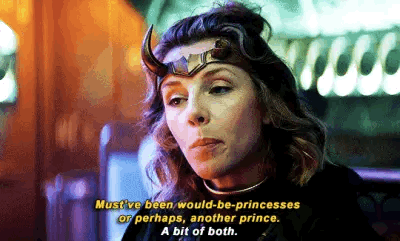
The dialogue, lighting, and costuming (blue, purple, pink) in this scene communicates they are both queer, specifically bisexual. The lighting and costuming combining to represent the bisexual pride flag is an example of queer subtext in film. The dialogue, while direct, is also written in such a way that it avoids explicitly stating "men and women." Sylvie later comments that the brief flings she indulges in during apocalypses helped her "keep going". She even specifies that apocalypses make people desperate. This suggests that Sylvie likely didn't need to do much wooing or charming like Loki would to obtain a sexual partner. Finally, the way Tom and Sophie play this scene is vulnerable. I therefore believe we can take this on-screen admission at face value.
So the question becomes, why does Sylvie respond to Loki's flirtations the way she does?
SYLVIE'S BACKGROUND
Sylvie was orphaned and forced to run all her life from a very young age. Her backstory is deeply tragic. To live in such a way means that she never had the opportunity to experience adolescence.

NOTE: This is honestly my favorite gif of Sylvie. She's so sweet and cute when she's happy. I can't get over the 5 stars on her employee badge. "Sylvie, can you refill the straws?" "Already did it!" The sweetheart.
Sylvie working at McDonald's accomplishes two things: it allows Disney to fulfill their advertising sponsorship agreement for the fast-food franchise, and it subtly alludes to Sylvie's need to live the adolescence she didn't get to. The TVA forced her into arrested development. She never had the chance to make friends and safely socialize on her own terms. The centuries of trauma have made trust, let alone romance, completely foreign to her.
Which is why, when Loki and Sylvie have romantic scenes, she is often awkward or, if not unreceptive, wary. Her previous flings, as she agrees with Loki, were "never real". Physical intimacy without emotional intimacy is a familiar dynamic for both characters. Their relationship with one another is their first experience of emotional intimacy (or at least attempt at it) outside of their families. The pursuit of this emotional intimacy feels safe to them because they are the same entity and thus they know each other's base nature (versus nurture!) to some degree.
The difference between them is that Sylvie has not experienced social rejection in the way Loki has (nurture!). She recognizes the wrongness with which the TVA has treated her. She knows the absolute atrocities the TVA has committed. She is determined to destroy them to free herself and all timelines. Sylvie is consequently more self-assured, more confident in what she wants and believes in, than Loki. In S2, Sylvie's clarity on desire is what allows her to help Loki articulate what he wants: his friends back, most especially Mobius.

In S1E1, Loki, still posturing before Mobius, describes himself as a "liberator". At this point in the story, we know that isn't true, but it will become true by the finale. This line of dialogue foreshadows Loki's trajectory as well as Sylvie's revealed motivation in S1E4: to liberate.
THE NEXUS EVENT
There are a variety of ways for viewers to interpret what exactly the Nexus Event was. The canon, within the text of Mobius's dialogue and verbal confirmation from the creators, is that Loki and Sylvie fell in love. Now, I'm not going to spend time arguing over other interpretations here, but I will say that regardless of whatever pairing or OT3 a viewer ships, the Nexus Event was ALSO definitively this: two Lokis in the same place, at the same time, not feeling lonely together.
And Sylvie, who had confessed to Loki she has no friends and has never really experienced joy, answers Renslayer with the number of positive memories she has:

Sylvie doesn't state it outright, but the subtext is clear that her one positive memory was her time with Loki on Lamentis. Indeed, moments later, Sylvie prunes herself in an effort to find and rescue him.
SYLVIE & MOBIUS

But being the harshly pragmatic individual she is, upon arrival and encountering Alioth, Sylvie assumes Loki didn't make it. I don't think Sylvie means what she says in a cruel way. I think she believes this because she is accustomed to disappointment and accordingly guards herself with cynicism. Sylvie's traumas, her difficulty with trust, her inexperience with intimate relationships, and her cynicism all combine to create an individual who may appear aro-ace when that may not necessarily be the case. Please note, however, that Sylvie being aro-ace or aro-bisexual may still be a possibility. My analysis here is based on what the text and subtext seem to be telling us about her character.
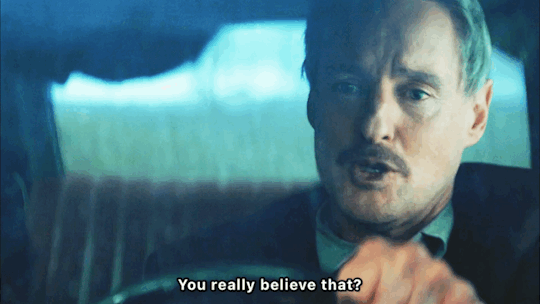
Notably, it is Mobius who is more optimistic about Loki's survival, wondering if Sylvie truly believes that Loki is dead.
This moment is brief, but it is significant because Mobius's optimism implies that not only does he believe in Loki, he also wants Loki to be alive. Sylvie is intelligent. She can read between the lines. We can also assume an off-screen conversation took place between them that confirmed for Sylvie Mobius's genuine care for Loki. When Sylvie informs Loki of this fact, I believe we get this:
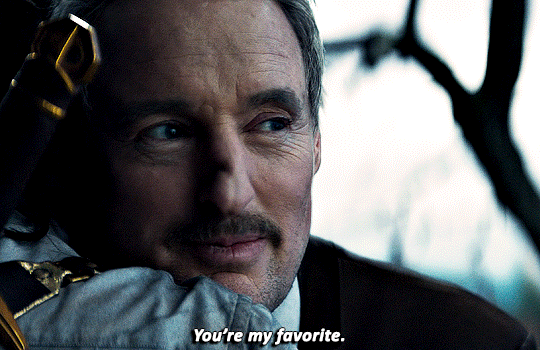
Mobius was conservative in how Loki might interpret their relationship, extending a handshake before their goodbyes. Loki, on the heels of his conversation with Sylvie, chooses to hug him instead. The result: Mobius is delighted!
I've long pondered on why Mobius would say, "You're my favorite" to Sylvie. I believe this is why: she helped along their friendship and opened the gates for physical affection between them. This demonstrates that Sylvie cares enough for Loki to ensure he is secure in his bond with Mobius. It likely helped that Mobius did not deny the TVA's evil when she pointed it out to him, and that he did not hesitate to apologize to her for it.
Ironically, it is Mobius's optimism, especially in the potential of broken things to become something better (whether it is Loki himself or the TVA), that creates the fraught philosophical divide between Sylvie and Mobius (and Loki) with regards to the TVA in S2.
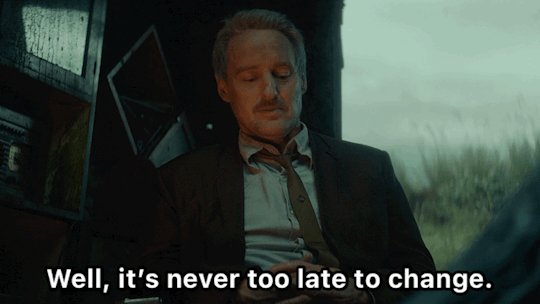
THE S1 FINALE
The S2 finale is where the narrative between Loki and Sylvie turns, and the plot pivots to the deepening relationship between Loki and Mobius. Triggering this event is Loki's desire to slow down and think about the consequences of killing HWR in the Citadel at The End of Time.
This may seem out-of-character at first glance. S1E1-E4 have demonstrated that Loki's decision making is sometimes chaotic by virtue of impulse. What was the last impulsive decision he made with heavy consequences?


He ran off after Sylvie. A good decision ultimately, as Loki learns the truth about the TVA through Sylvie, but only by luck. This decision very nearly cost Loki a friendship, one he didn't even realize he had until Mobius called him a "bad friend."
Despite the fallout, Mobius recovers relatively quickly once he confirms Loki's claims and views Ravonna's recording of C-20. He reestablishes trust with Loki as soon as possible to help Loki be with the one he loves. Why? Because Mobius is ultimately selfless and wants Loki's happiness regardless of his own feelings of jealousy.
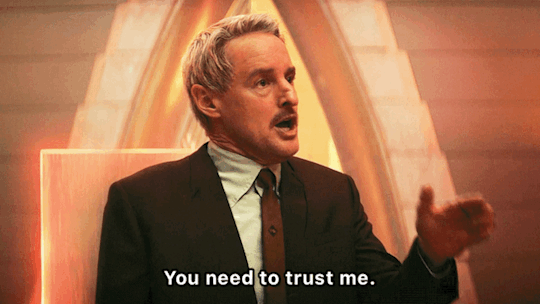
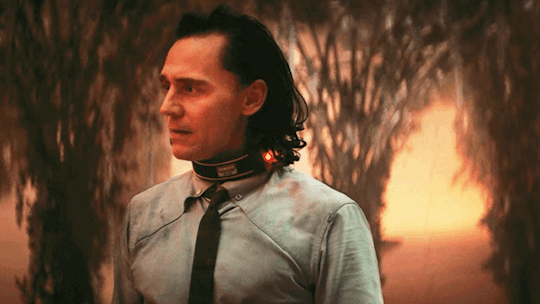
Which circles us back to the theme of trust and Sylvie's challenges with it.
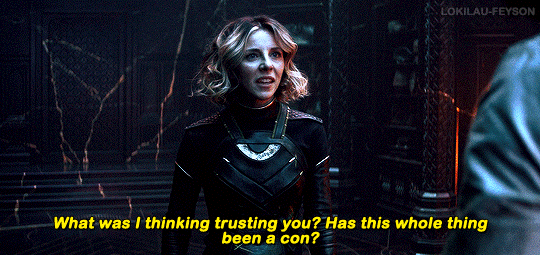
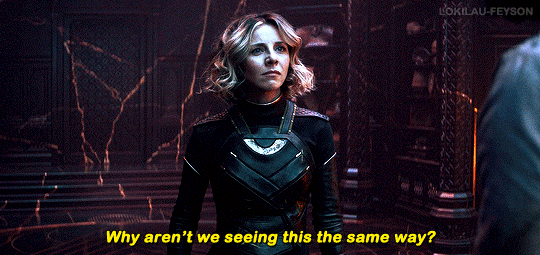
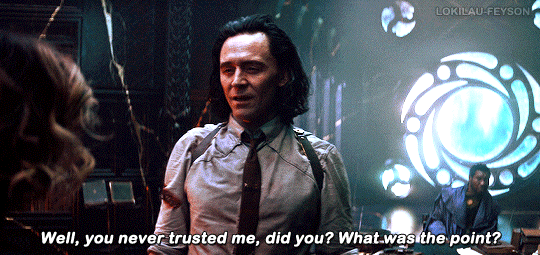
Loki and Sylvie's relationship falls apart not because of lack of mutual interest, but because Sylvie loses trust in Loki and with good reason: HWR (and thus the TVA) is the cause of all her suffering.
It is not Sylvie's fault she is this way. She hasn't had enough time to develop meaningful relationships, and the one relationship that was meaningful to her (Loki's) became, in her eyes, a profound betrayal. This experience only adds to the other traumas Sylvie carries with her, making encounters with Loki in S2 emotionally difficult if not triggering.
The relationships of Loki & Sylvie and Loki & Mobius are intentionally set side-by-side for 3 critical reasons:
1.) To demonstrate Loki's growth by developing trust and thus emotional intimacy with others.
2.) To create the Plot B emotional source of conflict in S2.
3.) To set-up Mobius and Sylvie's individual beliefs and values (selflessness and sparing life [Mobius] + free will and revolution [Sylvie]), which Loki combines into his own system of beliefs and values. This combination gives Loki the strength and wisdom to ascend the throne and become the God of Stories (and Time).
THE S2 FINALE
Loki comes to his final decision after speaking with the two halves of his character arc equation. Loki first seeks out Mobius, who shares with him the distinction between himself and Ravonna. Now, this is brainwashed Mobius. Brainwashed Mobius believed Ravonna could do the impossible while he couldn't. But Loki knows Ravonna's corruption.
Beneath Mobius's wisdom that "most purpose is more burden than glory" is also Mobius's heart: he could not prune children and that instinct was the right decision. His "failure" was not a failure of duty but rather his humanity succeeding despite the brainwashing. It's this same intrinsic compassion that drove Mobius to convince Ravonna to spare Loki. Loki articulates this to Don as such. He therefore takes the message of selflessness and sparing life from Mobius to Sylvie.

Sylvie, in turn, challenges Loki, stating they should have the freedom and right to fight whatever comes on their own terms.
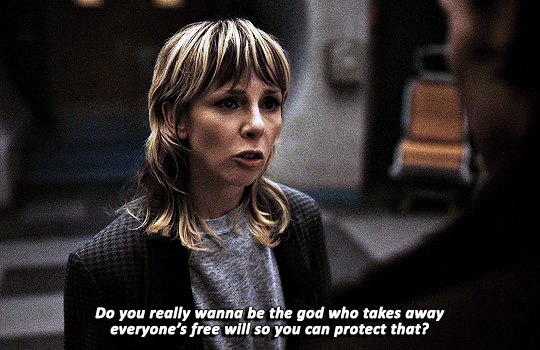
She also stresses that it is all right to destroy things. Upon hearing this, Loki comes to the conclusion that what is destroyed must be replaced with something better. What needs to be destroyed? Not the TVA and the people in it (not Mobius, Verity, OB, and Casey), but the Loom.
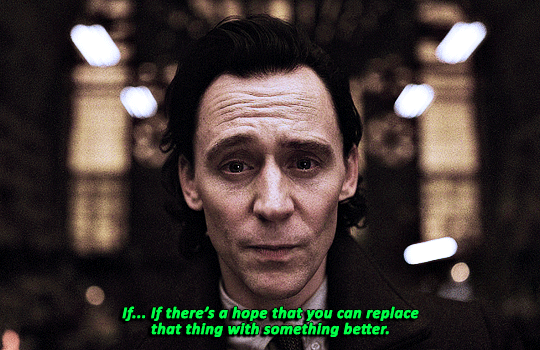
Loki sacrificed himself (selflessness + sparing life [Mobius]) in order to save all timelines (free will + revolution [Sylvie]). Loki sparing Sylvie's life is a direct consequence of Mobius having fought to spare his.
Through this sacrifice, Loki gifts Sylvie the chance to get the type of positive experiences she wants and needs, which includes future romance, if she so chooses. That is canon and is a genuinely romantic gesture regardless of anyone's interpretation of mutual reciprocation or lack thereof.
It is also canon that Loki loves Mobius and Mobius loves Loki. Their actions for one another across both seasons demonstrate this to be true. Is it also romantic? Absolutely. Is it sexual? On screen, no, and it doesn't have to be. Romance does not require sex, let alone physical contact, to exist.
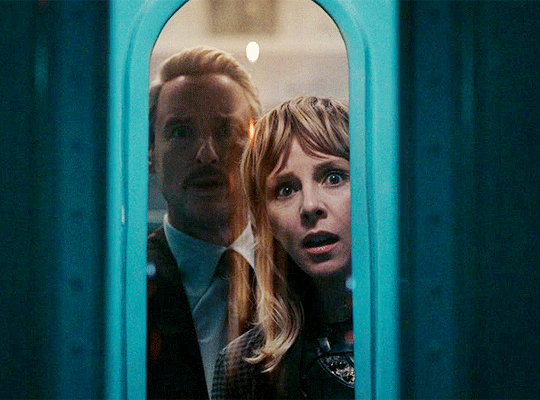
Loki loves them both.
89 notes
·
View notes